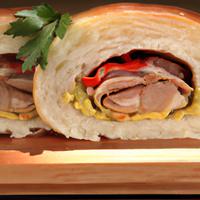
1 serving (150 grams) contains 300 calories, 10.0 grams of protein, 8.0 grams of fat, and 50.0 grams of carbohydrates.

Log this food in SnapCalorie

Nutrition Information
Calories |
473.2 | ||
|---|---|---|---|
% Daily Value* |
|||
| Total Fat | 12.6 g | 16% | |
| Saturated Fat | 4.7 g | 23% | |
| Polyunsaturated Fat | 0 g | ||
| Cholesterol | 31.5 mg | 10% | |
| Sodium | 630.9 mg | 27% | |
| Total Carbohydrates | 78.9 g | 28% | |
| Dietary Fiber | 3.2 g | 11% | |
| Sugars | 7.9 g | ||
| protein | 15.8 g | 31% | |
| Vitamin D | 0 mcg | 0% | |
| Calcium | 78.9 mg | 6% | |
| Iron | 3.2 mg | 17% | |
| Potassium | 157.7 mg | 3% | |
* Percent Daily Values are based on a 2,000 calorie diet. Your daily values may be higher or lower depending on your calorie needs.
Food Attributes
Source of Calories
About Bread roll with filling
A bread roll with filling is a versatile dish enjoyed across various cuisines worldwide. These rolls consist of soft and fluffy bread encasing a variety of savory or sweet fillings, such as meats, cheeses, vegetables, jams, or custards. Popular examples include European stuffed rolls, filled bao buns from Asia, or Latin American empanadas. Nutrition varies depending on the ingredients used; rolls with lean proteins or vegetables offer vitamins and essential nutrients, while fillings high in sugar or saturated fats may be less healthy. The bread provides carbohydrates for energy but can also be high in calories, particularly if made with refined flour. Opting for whole-grain bread can increase fiber content, aiding digestion. Bread rolls with balanced fillings can be a satisfying snack or meal, while those with rich fillings and added sugars are better enjoyed occasionally.



